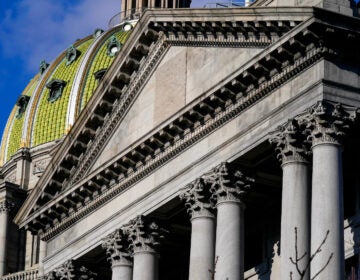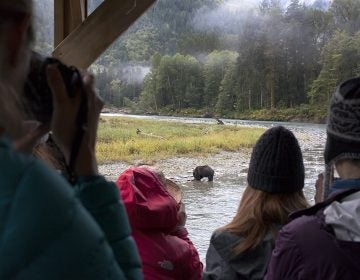Counting Alberta’s grizzlies: Are they recovering or still threatened?
Where one Canadian team works, there are rugged mountain peaks, foothills and vast meadows, as well as towns and farmland. How many bears live here?
Listen 08:43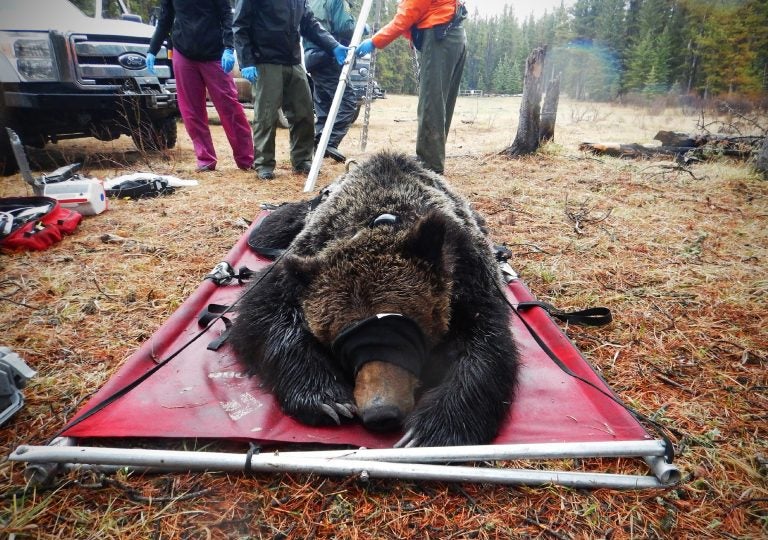
A field crew prepares to weigh a grizzly bear they have collared as part of ongoing research into Alberta's grizzly population. (Molly Segal/For WHYY)
In Alberta’s Rocky Mountains, east of a large national park in Canada, I join a team of biologists and volunteers trying to trap grizzlies to learn more about how these bears spend their time. They do this by fitting the grizzlies with radio collars that will continue to send GPS points for up to two years.
A big pickup truck pulls into camp, and Gord Stenhouse, head of the Foothills Research Institute’s grizzly bear program, steps out.
“Welcome to camp,” he says, as he starts checking in with his crew.
He tells me the group is hoping to fit up to 15 bears with radio collars this season. The team first needs to catch a bear before they can fit it with a collar, so I follow along with two members of the field crew, John Saunders and Dave Hobson, to see how it’s done.
Catching grizzly bears comes with its own challenges: not only setting traps, but baiting them in such a way to convince a bear to step inside.
When we arrive at the site, there’s a clearing in some trees where the trap sits. It’s a long, metal tube, with one end closed off, and the other has an opening with a trap door. The field crew attaches bait to the inside trigger. When it’s set off, the door will close.
Field crewmember John Sauders wriggles inside the trap to add fresh bait to the trigger — part of an elk that was hit and killed by a vehicle in the nearby national park.
“Everything depends on tempting that bear to get in that trap,” he says.
“It’s like feeding Dave doughnuts,” Saunders jokes as he cuts off bits of elk to add to the scene.
Outside the trap, they scatter pieces of meat around, hoist some up in a tree, and garnish it all with fermented blood — which leaves a strong scent that can get caught in the wind and, hopefully, grab a bear’s attention.
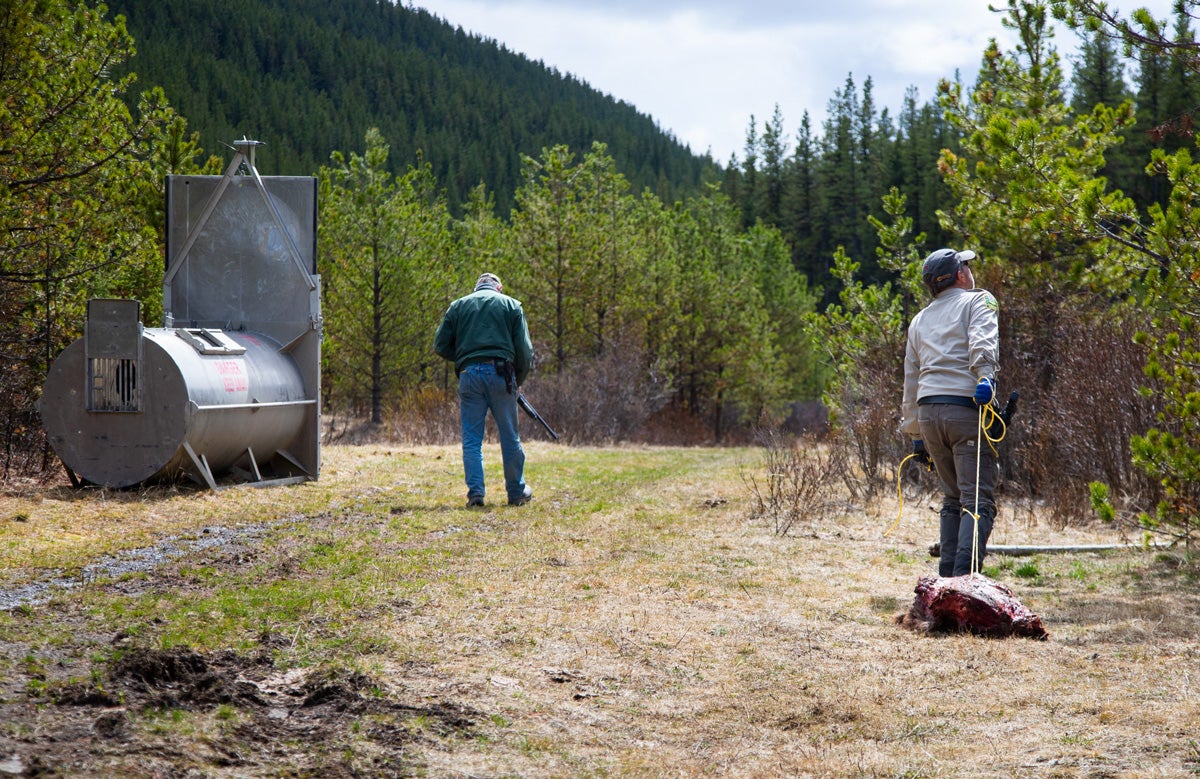
The team’s current research area is about the size of Massachusetts and covers part of a national park, public land, campgrounds and wilderness areas, as well as land used in industries such as forestry and oil and gas exploration. It’s one of seven grizzly bear management areas in the province of Alberta. Grizzlies are considered a threatened species here.
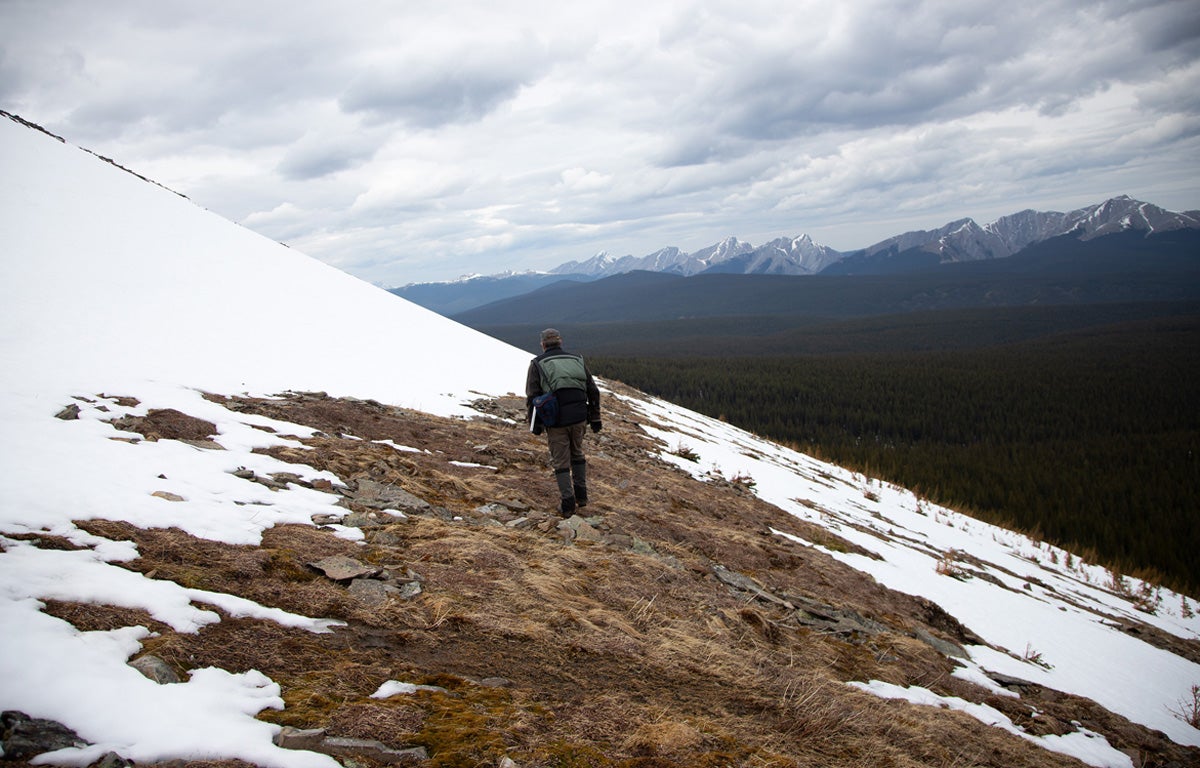
Where Stenhouse and his team are working, there are rugged mountain peaks, foothills and vast meadows, as well as towns and farmland. How do grizzly bears deal with all of that, the team wants to know?
Last year, this team collected hair from bears here using barbed-wire snags. DNA from that hair is being analyzed to get a better estimate of how many bears live in the area. Pair that with the radio collars, and a clearer picture of bear numbers and movements will emerge.
“Over time,” says Stenhouse, “if we have more recreation or more human activity in an area, are bears being pushed out or displaced from that area and then being forced into areas where you might have more conflict with agricultural areas or with the ranching community?”
It’s a question the radio collar data can help answer. And it’s an answer communities living in bear country are keen to know.
“If we have a resident bear population that is staying within the ranching area, the ranching community, we need to know that,” says Paul Fraser, who lives in Bearberry, where he and his partner raise yearling cows.
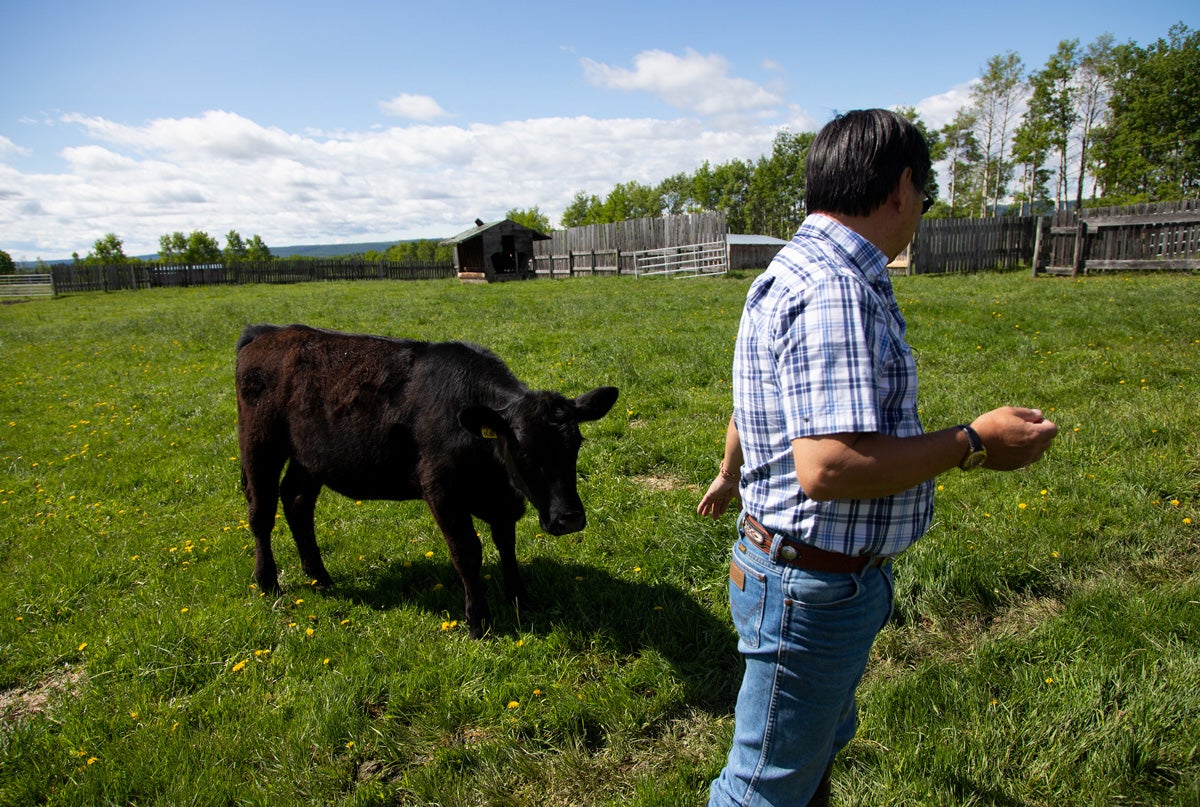
Though their property is surrounded by other ranches, acreages and even a meadery, with only a glimpse of the mountains in the distance, it’s still part of the research territory Stenhouse and his team are working in.
Fraser is a trained wildlife biologist and works with local ranchers to prevent conflict between humans and bears as part of the local BearSmart Society.
If grizzly bears are “staying here, we need to manage for them to be here … the whole point is trying to coexist with the bears here,” he says.
It’s no secret to Fraser or anyone else that lives here that grizzly bears are around. What isn’t clear is where exactly they spend their time and how long they are hanging out in the area. That’s why he is helping Stenhouse find ranchers and farmers who are seeing grizzly bears on their properties regularly and are open to having bear traps on their land for a few days.
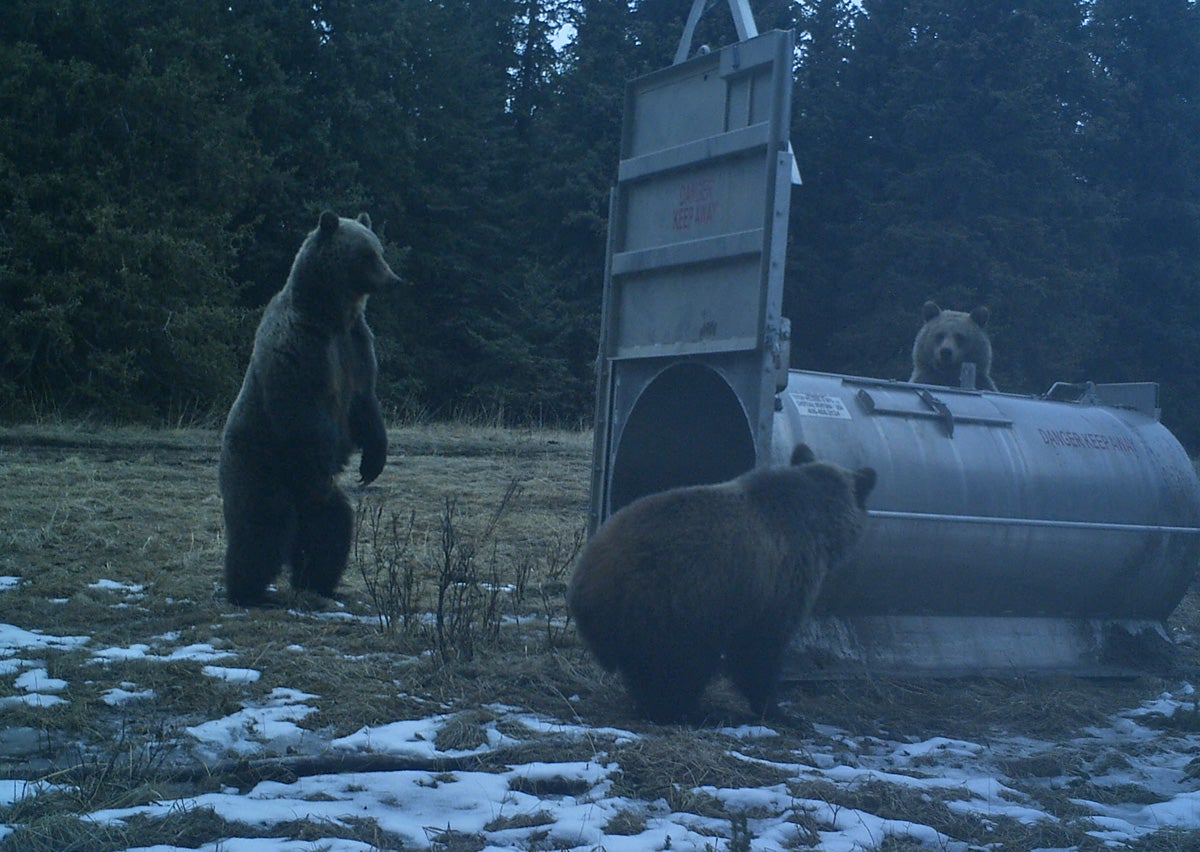
Farmers and ranchers in his community want to know how many bears are on the landscape. “They want an absolute number, and we can’t give them that,” Fraser says.
Compared to 10 years ago, he says, “everybody’s seeing more bears, at least … what they’re saying is, ‘we’re seeing way more bears here on the landscape … and we think there’s potential for human-bear conflict to happen again.’”
On two separate occasions, individuals were mauled by mother grizzlies with cubs and died as a result of the injuries.
“What they would like to see is a hunting season open up for grizzly bears,” Fraser says.
It’s been illegal to hunt grizzly bears in Alberta since 2006. But Stenhouse says many grizzlies are shot and killed in the province illegally.
“Some people might be afraid of bears, which I understand at some level, and some people just might not accept that there [are] grizzly bears coming into areas where they haven’t seen them before,” he says. “You go and speak to a rancher who might have lost a calf or cattle or sheep to a bear, and they might believe there’s too many bears.”
Stenhouse hopes the Foothills Research Institute’s data will help the province determine what it might mean for grizzly bears to be considered recovered in the province rather than threatened. Though the team’s main goal during the field season is to put collars on grizzlies, it’s not every day that a bear gets caught in a trap.
By the last morning with the crew, I have yet to see a bear captured, when Stenhouse makes an announcement.
“We had an alarm last night … and we hope that there’s a bear inside the trap, so we’re just going to go check that.”
We drive to the site, where he instructs me to stay in the vehicle for now. The trap is one of the long, metal cylinders, and from where I am it’s hard to tell whether there’s a grizzly inside — there’s no noise or sound coming from inside the trap. Stenhouse approaches it carefully and opens a small window at its side. Suddenly, the trap starts shaking.
“Yes, indeed, it’s a bear,” he says. “And it’s a grizzly bear.”
Two people prepare a dart with a drug to immobilize the bear. Once the grizzly is out cold, Stenhouse tells me I can get out of the truck to get a closer look at how the team does its work. The bear’s breathing is slow, and it smells like a wet dog — but stronger.
Once Stenhouse makes sure the bear’s oxygen levels are good, everyone kicks into high gear to get their work done. They have roughly an hour before the bear will wake up.
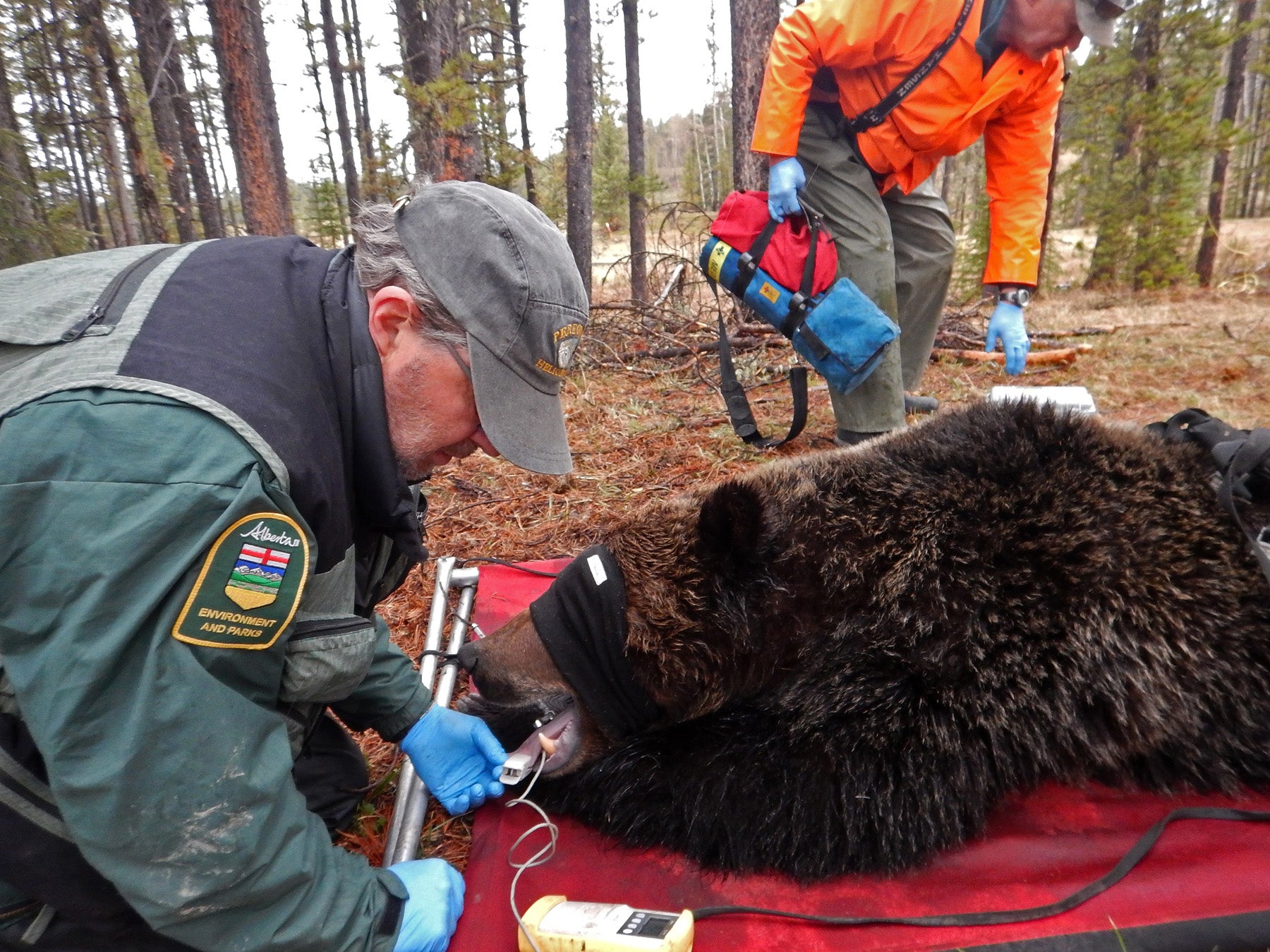
Stenhouse rattles off instructions to the five-crew members, assigning different tasks: “You can start sampling. You’re gonna be on shotgun. You’re on collar.”
The crew moves swiftly in tandem to get through a list of samples to take: a vestigial tooth the size of my pinky fingernail that will tell them how old the bear is; blood and hair along with a small skin biopsy, all to be analyzed later. Listening in, it sounds like we’re in a hospital.
“You’ve got your biopsy?” asks Stenhouse. “So now we need another round of vitals. So you’ve got rectal temp and respiration, please.”
As part of their work, they insert a microchip under the bear’s skin, similar to the ones veterinarians put in pet cats and dogs. Each time the team’s members catch a grizzly, they scan it to see if it already has a microchip, which would tell them they’ve caught that particular bear before.
One of their last tasks is to measure and weigh the bear; this particular grizzly is 338 pounds. They secure a radio collar on the bear, and then prepare to inject the grizzly with a drug that will wake him up. Suddenly, the bear lets out a huge breath.
“When you start hearing those big breaths like that,” says Stenhouse, “that means the bear is coming out of that anesthetic plane … that’s what you want … that tells you should be finishing.”
Just as quickly as it unpacked, the team packs up its gear and we all pile into trucks. While the others drive off, Stenhouse will wait in his vehicle until the grizzly starts to wake.
This bear has become a moving data set that will send Stenhouse and his team GPS points for up to two years. That data may help answer questions that will help keep grizzly bears like this one in Alberta for years to come.
WHYY is your source for fact-based, in-depth journalism and information. As a nonprofit organization, we rely on financial support from readers like you. Please give today.





